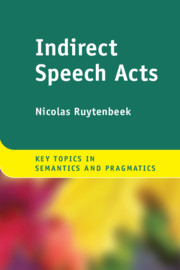Indirect Speech Acts
To achieve successful communication, it is crucial to say clearly what we mean, but, at the same time, we need to pay attention to the form of our utterances, to avoid misunderstandings and the risk of offending our interlocutors. To avoid these pitfalls, we use a special category of utterances called 'indirect speech acts' (ISAs) that enable an optimal balance between clarity and politeness. But how do interpreters identify the meaning of these ISAs? And how does the social context influence the use of ISAs? This book attempts to answer these questions. It deals with the main theoretical and empirical questions surrounding the meaning and usage of ISAs, drawing on the latest research and neuroimaging data. Adopting a truly interdisciplinary perspective, it will appeal to students and scholars from diverse backgrounds, and anyone interested in exploring this phenomenon, which is so pervasive in our daily lives.
- Enables readers from different scientific and cultural backgrounds to understand the phenomenon of ISAs
- Makes methodological recommendations and suggestions for future research
- Illustrates the discussions with corpus-based examples from different languages, and includes a glossary
Product details
June 2021Adobe eBook Reader
9781108756587
0 pages
This ISBN is for an eBook version which is distributed on our behalf by a third party.
Table of Contents
- 1. Classic Speech Act Theoretic Approaches
- 2. The Semantics of Sentence-Types
- 3. Cognitive and Relevance-Based Approaches
- 4. The Comprehension of ISAs
- 5. Indirectness, Politeness, and the Social Context
- 6. Computational and Artificial Intelligence Approaches to Indirectness
- 7. Conclusion
- References
- Index.





